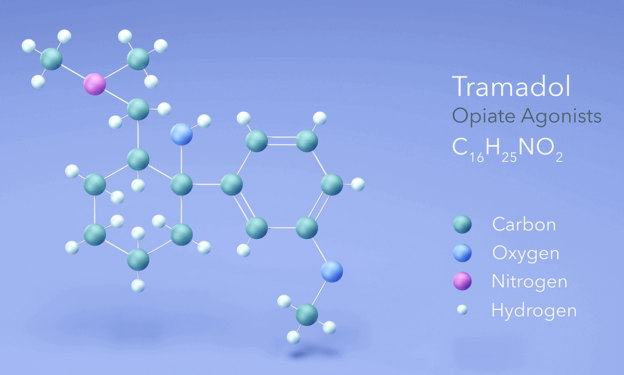As discussions about opioids and their implications on health continue to gain traction, many questions arise surrounding specific drugs like Tramadol. This article aims to address some of the most frequently asked questions about Tramadol, providing clarity on its classification, addictive nature, withdrawal symptoms, and the best approach for detoxification.
1. Is Tramadol an Opioid?
Yes, Tramadol is indeed classified as an opioid. Opioids are a broad group of pain-relieving drugs that work by interacting with the opioid receptors in your brain. When these receptors are activated, they can block pain signals from traveling along the nerves, thereby reducing or eliminating pain.
Tramadol is specifically designed to target and interact with these receptors, altering our perception of pain and how we respond to it. Unlike some opioids that are derived directly from the opium poppy plant, Tramadol is synthetic. This means it is man-made in laboratories. However, its chemical structure and the way it acts in the body closely resemble those of naturally occurring opioids. Its synthetic nature doesn’t make it any less effective or potent; in fact, its design allows for more consistent outcomes and dosages when compared to naturally derived opioids.
Furthermore, Tramadol has a dual mechanism of action. In addition to its opioid activity, it also has an effect on the brain’s serotonin and norepinephrine levels, which can contribute to its pain-relieving properties. This dual action makes it unique among opioids and is part of the reason it’s prescribed for various types of pain. However, like all opioids, it comes with potential risks and side effects, which is why it should be taken under the guidance and supervision of a medical professional.
For over 25 years, people from all over the world have chosen Waismann Method as their opioid detox provider.
We know the challenges you face and the importance of creating a unique and personal experience for you right from the start.Call for Detox Options 1-800-423-2482
2. Is Tramadol Addictive?
Certainly, Tramadol, like many other opioids, carries an inherent risk of addiction. The roots of this addictive potential can be traced to its interactions with the brain’s complex reward system. When taken, Tramadol can induce feelings of euphoria in addition to its pain-relieving effects. This pleasurable sensation can, for some individuals, lead to a desire to continue using the drug even after the original pain has subsided.
Prolonged and unchecked use of Tramadol increases the risk of both psychological and physical dependence. Psychological dependence refers to the emotional and mental processes that drive an individual to continually seek out and use the drug, even if they’re aware of its negative repercussions. Physical dependence, on the other hand, is characterized by the body’s adaptation to the drug. Over time, the body may come to rely on Tramadol to function “normally.” As a result, users might find that they need to consume larger quantities of the drug to achieve the same therapeutic effects – a phenomenon known as tolerance.
When someone dependent on Tramadol tries to reduce or stop its consumption, they may experience withdrawal symptoms. This can be a challenging phase, marked by physical and psychological discomfort, further emphasizing the drug’s addictive nature.
It’s essential to be aware of this potential for addiction and always use Tramadol as prescribed by a medical professional. If there’s a concern about dependency or any other side effects, it’s crucial to consult with a healthcare provider promptly.
3. What are Tramadol Withdrawal Symptoms?
Tramadol withdrawal can be a multifaceted experience, as the drug not only acts on opioid receptors but also affects the reuptake of neurotransmitters like serotonin and norepinephrine. Consequently, its withdrawal symptoms can resemble those of both opioids and certain antidepressants. When an individual who has developed a dependence on Tramadol stops taking it or reduces their usual dose significantly, they might experience the following withdrawal symptoms:
Typical Opioid Withdrawal Symptoms:
- Physical symptoms such as:
- Nausea and vomiting
- Muscle aches and pains
- Sweating or chills
- Diarrhea
- Yawning frequently
- Pupil dilation
- Goosebumps
- Runny nose
Psychological Symptoms:
- Anxiety or panic attacks
- Irritability
- Depression
- Agitation
- Restlessness
- Sleep disturbances, including insomnia
- Intense drug cravings
Symptoms Due to Serotonergic and Norepinephrinergic Effects:
- Confusion or disorientation
- Mood swings
- Hallucinations or unusual sensory experiences
- Strong headaches
Other symptoms:
- Rapid heartbeat or palpitations
- High blood pressure
- Seizures (in severe cases or when cessation is abrupt)
The severity, combination, and duration of these symptoms can vary widely among individuals and depend on factors like the length of time the person has been using the drug, the dosage they were taking, their general physical condition, and whether they were taking other drugs along with Tramadol.
Because of the potential complexity and discomfort of Tramadol withdrawal, individuals who wish to stop taking the drug are strongly advised to consult with a medical professional. A healthcare provider can offer guidance on a tapering strategy to minimize withdrawal symptoms or recommend other treatments and supports to help manage the withdrawal process safely and more comfortably.
4. Which is a safer option for pain management: Tramadol or Percocet?
Neither drug can be categorically declared “safer” than the other, as their safety profiles depend on individual patient factors, dosage, duration of use, and the specific nature of the pain being treated. Both drugs should be used under the guidance of a healthcare professional. Before prescribing, a physician will assess potential risks and benefits, considering factors like the patient’s medical history, potential for addiction, other medications being taken, and specific pain management needs.
5. What are the risks of taking high doses of Tramadol?
Taking high doses of Tramadol poses significant risks. It’s important to note that the effects of Tramadol, especially at elevated doses, can vary based on individual factors such as metabolism, other medications or substances consumed, underlying health conditions, and previous exposure to opioids. Here are some of the primary risks associated with taking high doses of Tramadol:
- Respiratory Depression: This is one of the most severe risks. High doses can suppress the respiratory system, leading to slowed or stopped breathing, which can be fatal.
- Serotonin Syndrome: Tramadol increases the levels of serotonin in the brain. Taking high doses, especially when combined with other serotonergic medications or substances, can lead to serotonin syndrome, a potentially life-threatening condition. Symptoms include agitation, hallucinations, rapid heartbeat, fever, muscle stiffness, and seizures.
- Seizures: Tramadol, at high doses, can induce seizures even in individuals who have no prior history of seizures or epilepsy.
- Increased Risk of Overdose: Taking excessive amounts of Tramadol dramatically elevates the risk of overdose, which can be life-threatening. Symptoms of overdose can include pinpoint pupils, unconsciousness, respiratory depression, and cardiac arrest.
- Addiction and Dependence: Higher doses amplify the drug’s addictive potential. Over time, individuals might develop both a physical and psychological dependence on Tramadol, leading to intense cravings and withdrawal symptoms when not consumed.
- Amplified Side Effects: Common side effects like nausea, dizziness, constipation, and sleepiness can become more pronounced at elevated doses.
- Cardiac Risks: Tramadol can affect heart rate and rhythm. High doses can pose risks, especially to individuals with underlying heart conditions.
- Drug Interactions: At elevated doses, Tramadol’s potential to interact harmfully with other medications or substances increases. This is especially true for drugs that depress the central nervous system, other opioids, or medications that influence serotonin levels.
- Cognitive and Motor Impairment: High doses can lead to significant impairment in thinking, decision-making, and motor skills, making tasks like driving or operating heavy machinery extremely dangerous.
- Liver Damage: Chronic use of high doses can put a strain on the liver, potentially leading to liver damage over time, especially if the patient consumes other hepatotoxic substances or medications.
If someone is suspected of taking a high dose of Tramadol or exhibiting signs of overdose, it’s crucial to seek emergency medical attention immediately. Always take Tramadol as prescribed and consult with a healthcare professional about any concerns or questions regarding dosage.
6. How Can One Detox Safely from Tramadol?
There are multiple avenues for Tramadol detoxification:
In-hospital Medical Detoxification
This method involves a controlled environment where the patient’s health can be closely monitored. Medical professionals are on hand to manage and alleviate withdrawal symptoms. This method is especially recommended for those with severe dependencies or underlying health conditions.
Rapid Detox
Rapid detox is a quicker method of detoxification under anesthesia. While the patient is unconscious, medications are administered to speed up the withdrawal process. The Waismann Method of rapid detoxification has gained attention as an alternative approach for treating opioid dependence, including Tramadol. While any treatment option has its pros and cons, here are some reasons why some believe the Waismann Method might be a good treatment choice for Tramadol dependence:
- Safety and Medical Supervision: The Waismann Method is conducted in a hospital setting under the close watch of medical professionals. This controlled environment ensures patient safety throughout the process.
- Speed: The method allows for rapid detoxification, reducing the time a patient spends experiencing withdrawal symptoms. This can make the process more comfortable and may be appealing to those who are anxious about prolonged withdrawal.
- Minimized Withdrawal Symptoms: Because patients undergo the rapid detox process under anesthesia, they don’t consciously experience the acute withdrawal symptoms. This can reduce the distress and discomfort commonly associated with opioid withdrawal.
- Comprehensive Care: The Waismann Method doesn’t just focus on detox; it also provides a comprehensive aftercare program. Patients often participate in an individualized recovery and aftercare plan, ensuring they receive psychological and emotional support after the detox process.
- High Success Rate: Anecdotal evidence suggests that many individuals who undergo the Waismann Method have a high rate of sustained abstinence from opioids. The structured approach can be a significant first step in long-term recovery.
- Focus on Comfort: Emphasis is placed on ensuring that patients are as comfortable as possible throughout the process. The use of medications to manage symptoms and the controlled environment both contribute to this.
Titrating with Your Doctor
Titrating, or gradually adjusting the dose of a medication, is another recommended approach for those looking to come off Tramadol. By working closely with a doctor, patients can slowly decrease their Tramadol dosage, reducing the intensity of potential withdrawal symptoms and making the process more manageable. This method requires regular consultations, patience, and strict adherence to the adjusted doses prescribed. It’s a favored approach for many because it minimizes sudden shocks to the system and can be tailored to individual needs and tolerances.
Choosing the right method to detox from Tramadol is paramount for safety and success. Whether it’s in-hospital medical detoxification, rapid detox, or titration under a doctor’s guidance, each has its advantages and potential risks. Consulting with healthcare professionals, understanding individual circumstances, and making an informed decision is crucial for a successful and safe transition off Tramadol.
Conclusion:
Navigating the complexities of pain management, especially with potent opioids like Tramadol, demands a combination of education, vigilance, and professional guidance. As with all potent medications, the key lies in striking the right balance between benefit and risk. Being informed is our first line of defense against misuse and the potential repercussions it carries. Whether you or a loved one is currently using Tramadol, contemplating its use, or considering detoxification, always prioritize open dialogue with healthcare professionals. Their expertise, combined with an individual’s informed decision-making, will pave the way for the safest and most effective approach to pain management. Remember, the journey through pain management is personal and unique, but no one has to traverse it blindly or alone.
Sources:
- MedLinePlus: Tramadol Information
- SAMHSA: Adverse Reactions Involving Tramadol
- NHS: Common Questions about Tramadol
- Healthline: Opioid Abuse and Addiction
Reviewed by Clare Waismann, a Master Registered Addiction Specialist (M-RAS) and Substance Use Disorder Certified Counselor (SUDCC II). Clare is the esteemed founder of Waismann Method® Advanced Treatment for Opiate Dependence and Domus Retreat®. Recognized as an authoritative figure in opioid dependence, opioid use disorder, substance dependence, and detoxification treatments, Clare Waismann’s expertise extends to detox recovery and various other subjects discussed on RapidDetox.com.






